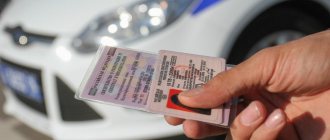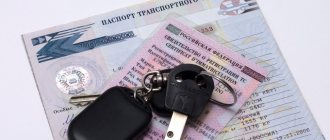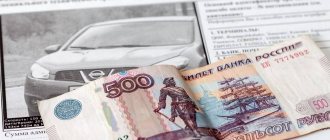Have questions? Get advice from a car lawyer:
8 (800) 350-29-83 — Regions of Russia 8 Moscow and Moscow region. 8 St. Petersburg and Len. region
It's fast and free!
Parking maneuvers are used every day by every car driver. If this action is performed correctly, the car will be placed in a free space in accordance with the rules of the road. This way the vehicle will be safe and will not endanger the movement of other cars. One such maneuver is parallel parking. It is included in the list of mandatory exercises when passing the driver's license exam. More details on how to parallel park on a race track are discussed below.
Parallel parking at the motorway
To obtain a driver's license, the driver must demonstrate a reverse parallel parking maneuver on a race track. The exercise is carried out on a special area that simulates a road surface. In addition to special markings, there are several traffic police cones on the site that the driver should not touch during a maneuver. If the task fails, the exam is terminated and the driver is sent to retake. Some features of passing the PP exam:
- Traffic police rules state that the PP maneuver must be demonstrated in one go, and reverse gear can only be engaged once. If the driver hesitates, he will be sent for a retake.
- Some minor parking errors are not a reason to send the driver to a retake, unless the number of errors exceeds a certain limit (we will look at this issue in more detail below).
- Please note that during the second part of the exam (in the city), the traffic police inspector may ask the driver to demonstrate the PP maneuver. Failure to park may be the basis for sending a person to a retake.
Exercise Dimensions
The parking “pocket” is twice as long as the car itself and one meter wider. Models vary, but according to the 2021 rules, all cars whose dimensions differ from the basic ones by a maximum of 30 cm are handed over according to standard markings at the race track.
At most autodromes, a car with a length of 4 m, 40 cm and a width of 1 m, 80 cm is considered basic; conditional parking is marked based on these data - that is, the length of the space will be 8 m, 80 cm, and the width - 2 m, 80 cm Models that are too long, as well as “bugs” that do not reach 4 m 10 cm, are not allowed for delivery according to standard markings.
Parallel parking in reverse
Reverse parallel parking is a method of parking a vehicle in a line with other cars, in which the car is parked between two cars. PP is performed in several stages:
- A man moves along the road and stops next to a vehicle in front of which he plans to park his car.
- After this, the driver reverses into the parking space. Entry is made at an acute angle to the roadway (that is, the driver turns the car slightly).
- If a person wants to leave the parking lot, he takes the car off the handbrake, turns the steering wheel and drives out onto the roadway at low speed.
- While driving, the driver must comply with a number of mandatory rules that relate to the operation of headlights, direction of movement and some other parameters (we will look at detailed step-by-step instructions for the PP below).
Parallel parking in the city
Parking in reverse in the city is the main method of parking vehicles in the city. This parking method is convenient because it allows you to occupy an empty space between two cars. For example, initially there were three cars parked in a row, but after some time the car located in the middle left the parking lot. As a result, a gap has formed between the remaining vehicles, where a new driver can park using the PP method.
The checkpoint spaces are not marked with any special markings or signs, and by default the driver can park between cars between checkpoints on any public roads.
Please note that on some sections of the road the PP may be prohibited.
Main cases:
- Road sections located near intersections or pedestrian crossings.
- Areas marked with prohibitory signs (for example, a round blue sign with a red cross).
- Single-lane village or rural roads whose width is below a certain limit.
- Areas near which a traffic accident occurred.
- Road sections with special parking regimes (for example, parking on even/odd days).
The main problems in performing maneuvers in the city
Implementing PP in the city poses some challenges. We list the main problems that drivers face most often:
- Possibility of maneuver. Parallel parking in reverse is ideal for lightly trafficked roads, as well as for the evening when there is not too much traffic on the road. In the case of a busy road, you may encounter situations where the maneuver is impossible for technical reasons. For example, you found an empty space between the vehicles, you already drove up to the car to reverse into parking - but at that moment you discovered that another car was backing you up in the lane. In this case, you will have to look for another parking place, since the PP will not be possible in this case.
- Technical features of parking. As mentioned earlier, traffic rules impose a number of restrictions on vehicles during a parking maneuver. For example, the driver needs to remember to turn on the turn signals to signal to other cars that you want to park. You also need to pay attention to the location of the car after parking - the vehicle should be at the same level relative to other cars. Violation of parking rules is subject to administrative liability, although some violations are rarely punished due to the difficulty of recording them. In fact, they are usually fined for improperly positioning a car in a parking space, since it is easy for a traffic police inspector to prove such a violation.
Leveling the car
The process of parallel parking is a rather difficult undertaking for a beginner, requiring constant training.
The final stage is the simplest, and if you managed to cope with the first three, then the final part will pass without any problems.
- We engage first gear, slowly turn the steering wheel straight and slowly level our car.
- If it doesn’t work out right away, you can carefully back up and repeat the maneuver again.
The process of parallel parking is a rather difficult undertaking for a beginner, requiring constant training. If possible, choose a suitable area without cars, place two objects at a distance of 3-4 meters and try to squeeze between them. Constant training will make you more confident to perform such maneuvers in city traffic.
In urban conditions, even an experienced motorist may need the help of a passerby to help him park. If you have the means, you can use an electronic assistant.
Cameras are installed at the front and rear, which transmit images to a monitor installed in the cabin. A picture of what is happening behind makes the parking process much easier. Such systems are quite affordable and can be purchased on many sites on the Internet.
Parallel parking procedure
So, let's now find out how to correctly perform a parallel parking maneuver on a race track. Please note that the same instructions can be used for parking on the road. Instructions:
- First, you need to drive up to the checkpoint area at low speed. Near the entrance to the site, bring the vehicle to a complete stop and inform the instructor that you are ready to take the exam.
- After this, start the engine and start driving at low speed. You need to cross the white dotted line so that the traffic police cone is next to the rear right wheel of your vehicle.
- Now turn on the side turn signals and reverse, but do not change the direction of the steering wheel. When reversing, drive so that the rear wheels are completely outside the white dotted line.
- Now turn the steering wheel all the way to the right to reverse. Don't forget to keep moving. As a result, you must enter the parking sector.
- Look in the left rear-view mirror - as soon as the traffic police cone appears there, located at the very corner of the circuit, sharply reduce the speed of the car.
- Turn the steering wheel so that it is level. Reverse until the left front wheel crosses the marking line separating the parking sector from the roadway.
- Turn the steering wheel all the way to the left, and then continue driving in reverse. As a result, you must enter the parking sector completely.
- As soon as your car is parallel to the “roadway”, bring the car to a complete stop and put the handbrake on. After this, you can leave the car.
Useful tips
Any citizen, especially one who has recently gotten behind the wheel, should consider a number of things in the city before parking in reverse:
- Place and its dimensions . This is not a race track, they won’t scare you if you don’t pass, but if the car is too big, then other drivers can catch it. In addition, a stationary car should not interfere with the passage of others.
- Possibility of stopping . Not everyone pays attention to whether standing in the selected area is allowed. This often leads to a visit from a tow truck and showdowns with traffic inspectors. Before entering, they look at what signs surround the parking lot, and not who has already parked there.
Errors during execution
While executing software, you can make many mistakes. Some errors are not critical - if their total number is not too large, then the exam will be credited to you.
However, there are also quite serious mistakes, the commission of which can result in being sent to a retake.
Let's look at the main types of mistakes that are most often made at the race track:
- The driver hit the traffic police cones. This mistake is easy, and according to the traffic police rules, you can knock down no more than 2 cones on the site. If you knock down 3 cones, you will be sent for a retake.
- Complete engine stop. During the PP you should not completely stop the car - this is a mistake. Fortunately, stopping completely is an easy mistake, and you can do it no more than 2 times to pass the exam.
- Deviation from the specified test trajectory. If you incorrectly crossed the white markings or incorrectly positioned the car at the end, this is considered an error. Unfortunately, this mistake is serious - for it you are sent to retake.
More about the exercise
The marking of the territory roughly replicates the real urban situation in the parking lot, where a novice car enthusiast will have to squeeze in. Before starting the task, the cadet studies the outline of the task and memorizes it, then reproduces it while driving - from memory and the instructor’s comments.
The evaluation criteria are strict - three penalty points and no credit will be accepted.
This is explained by the fact that in parking lots and parking lots, a motorist is guaranteed to hit someone else’s car or even a pedestrian when leaving or entering, unless all the techniques are practiced to the point of automaticity.
Parallel parking instructions
To study the rules of PP, you can also use our pictures, which act as instructions. These pictures can be downloaded to your phone or printed if necessary. Please note that according to traffic regulations, these pictures should not be in the car during the exam.











